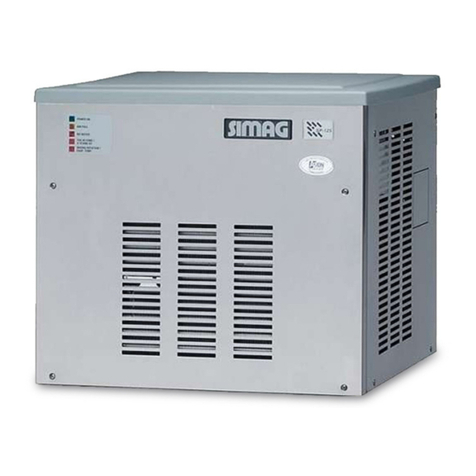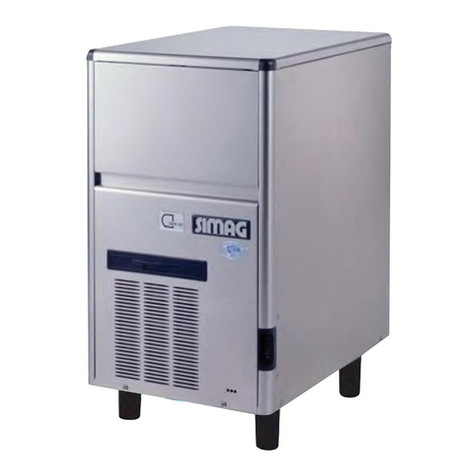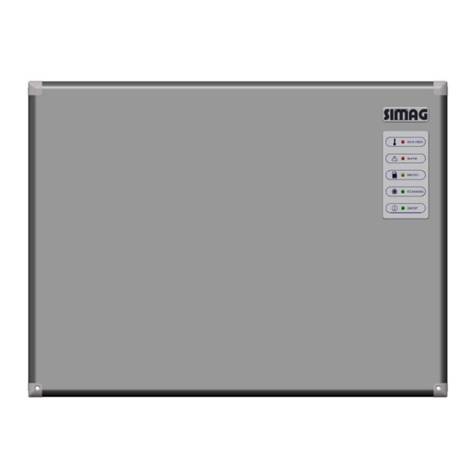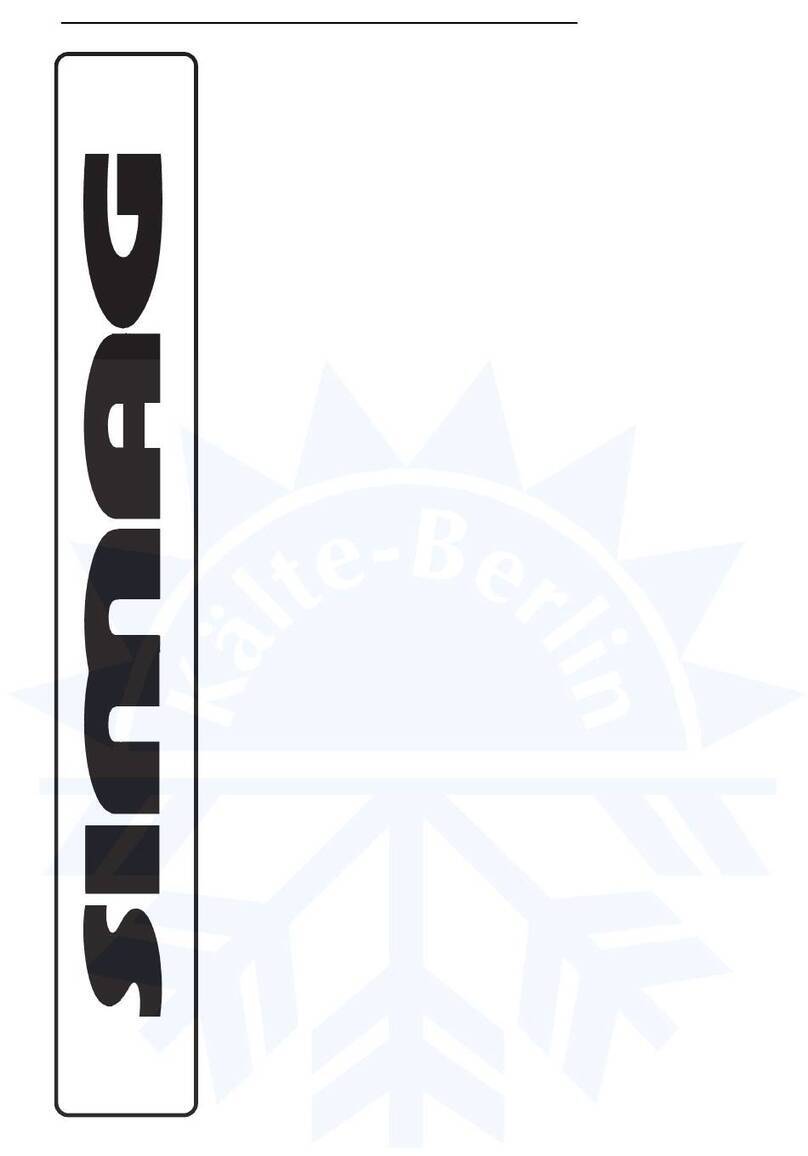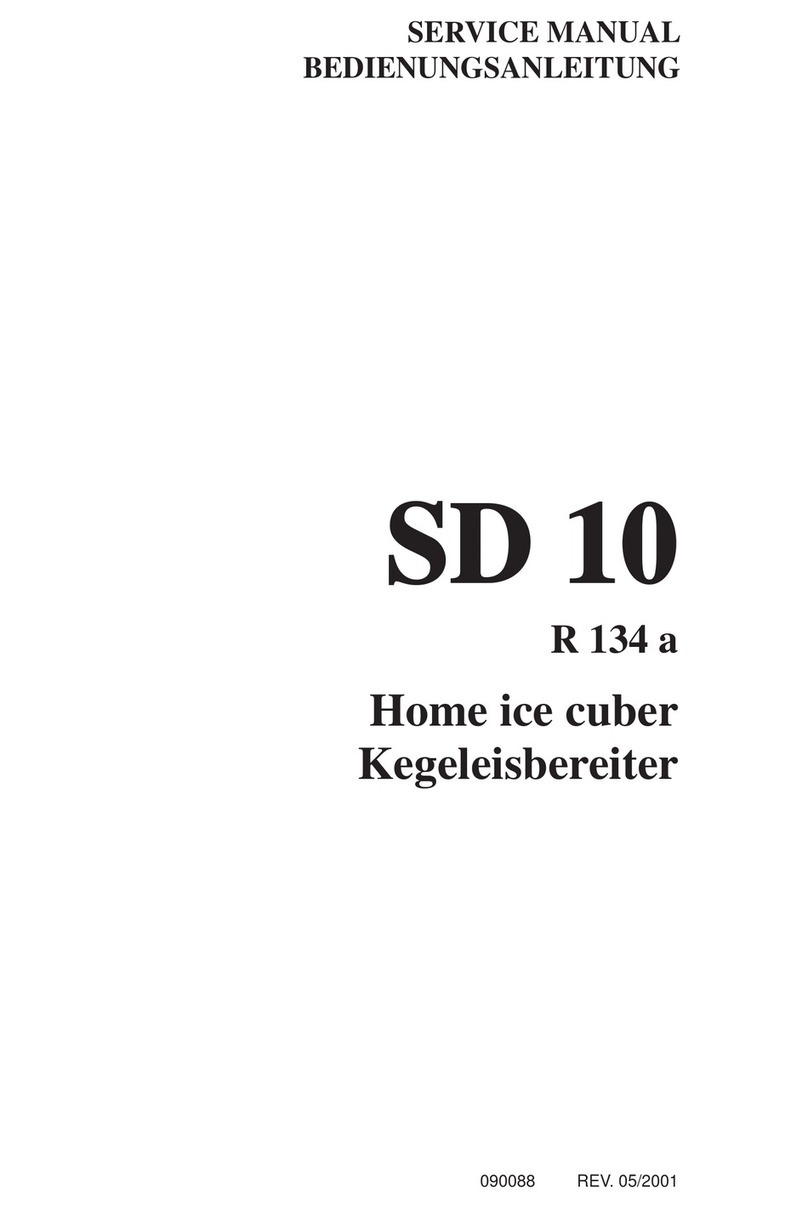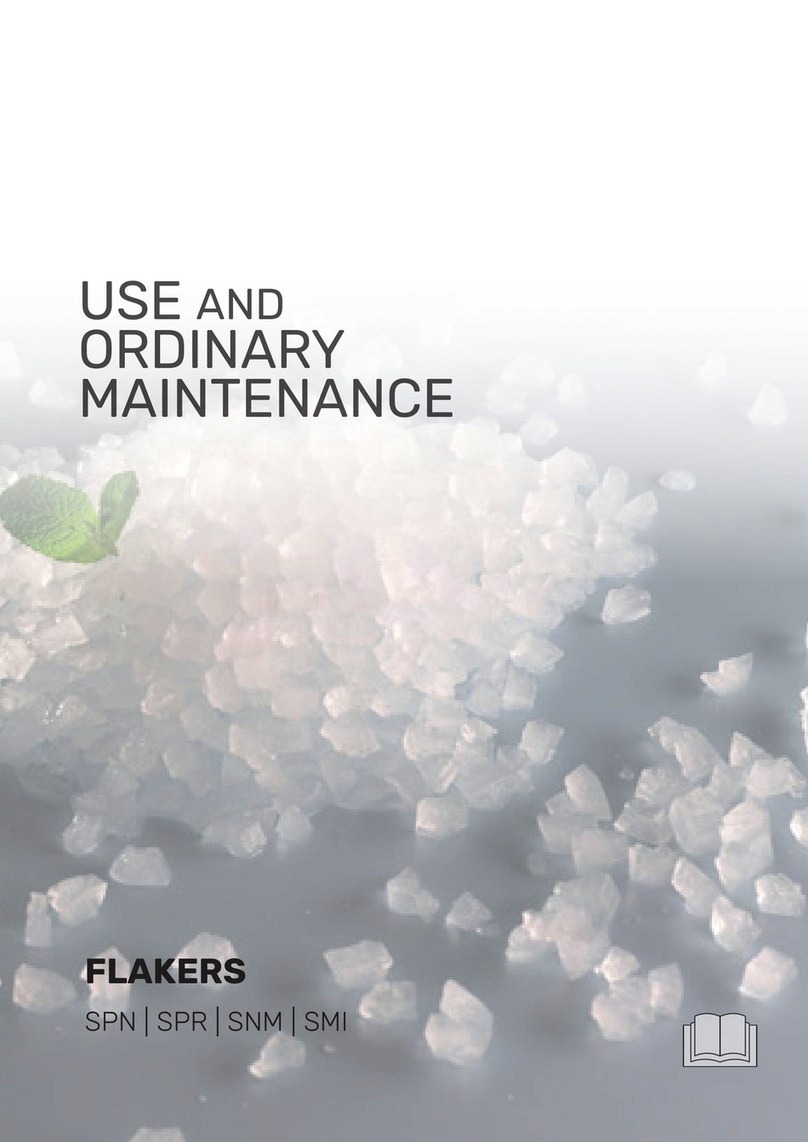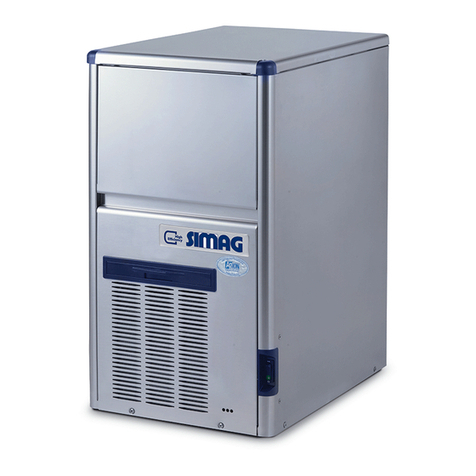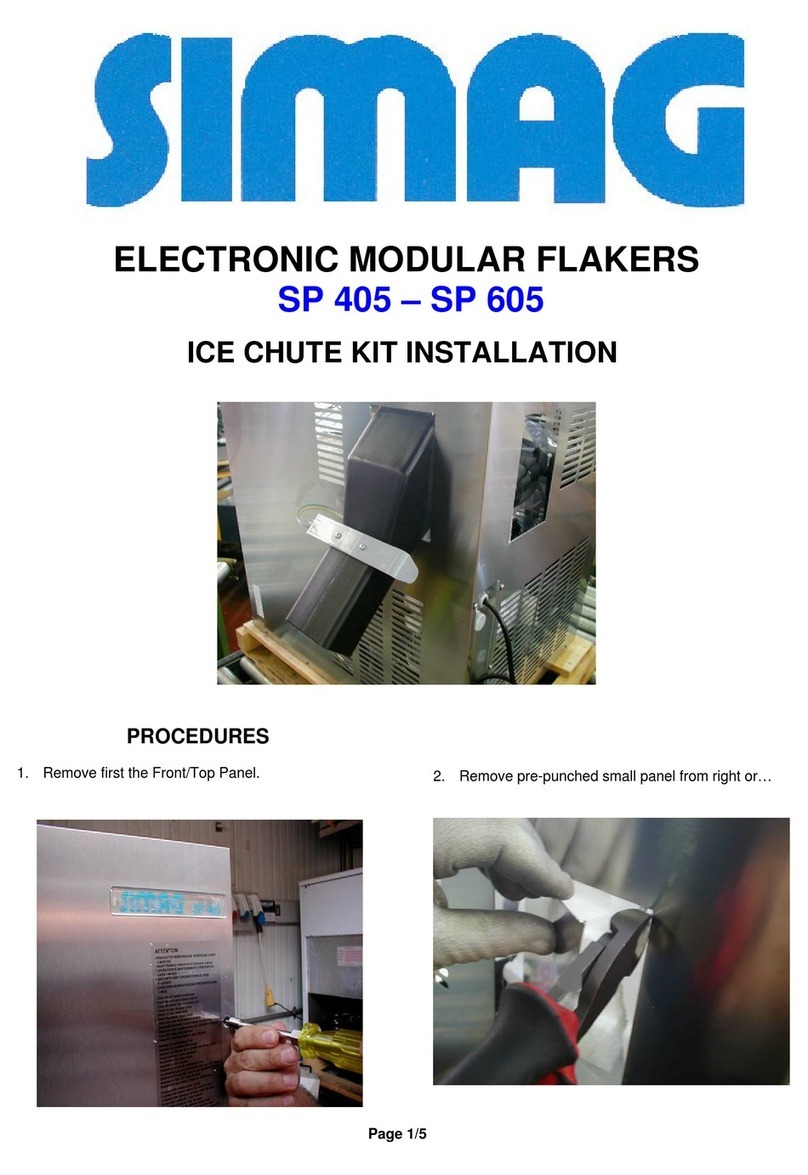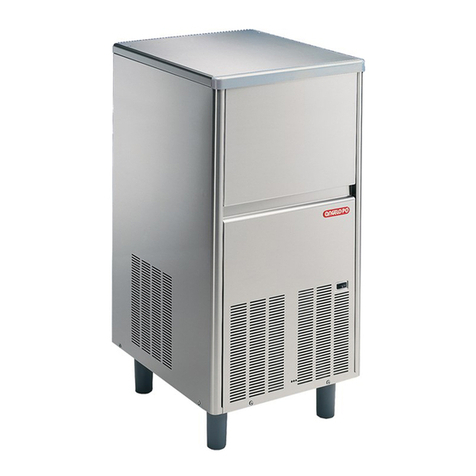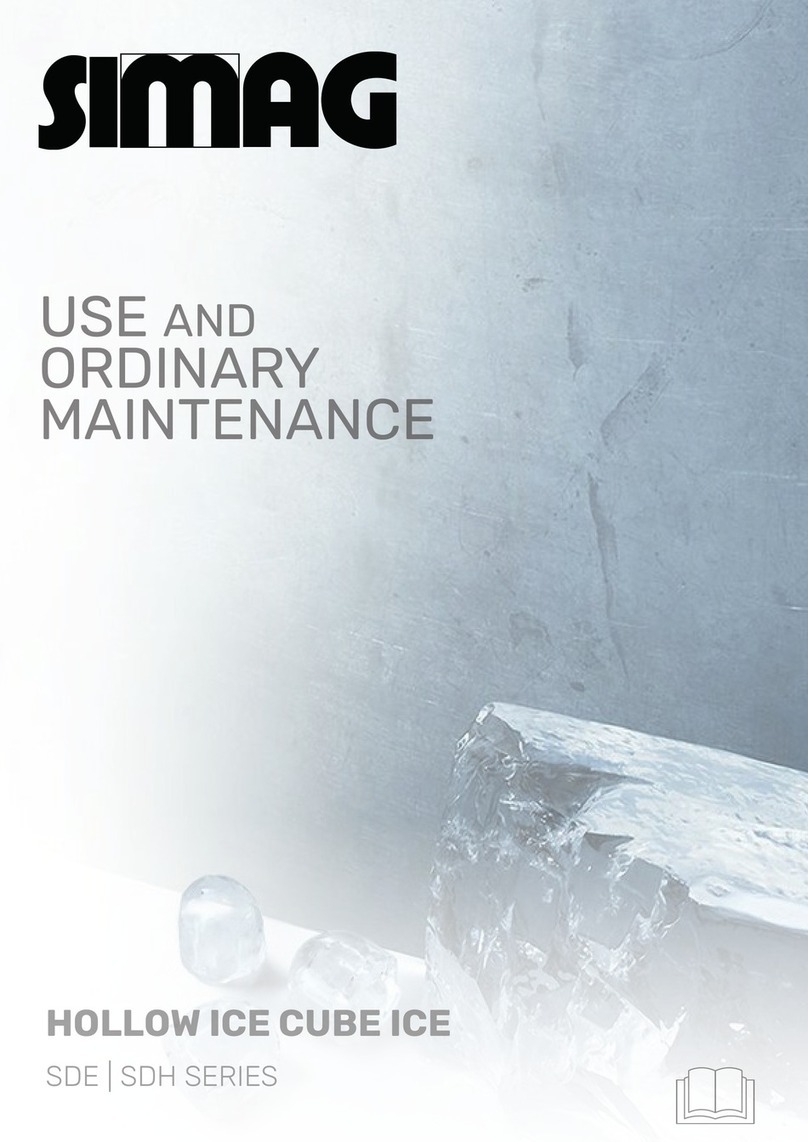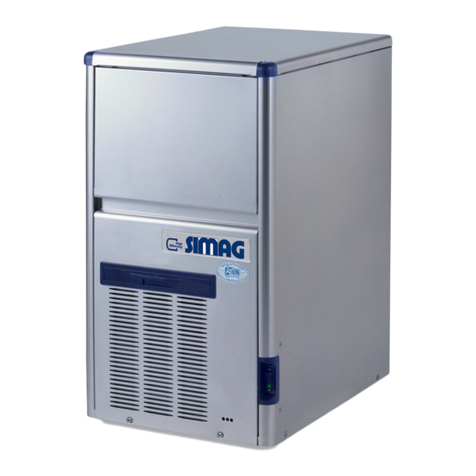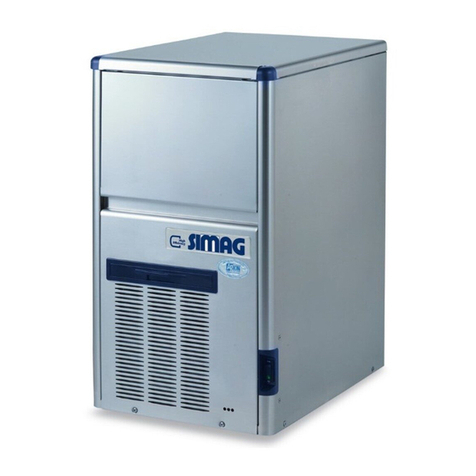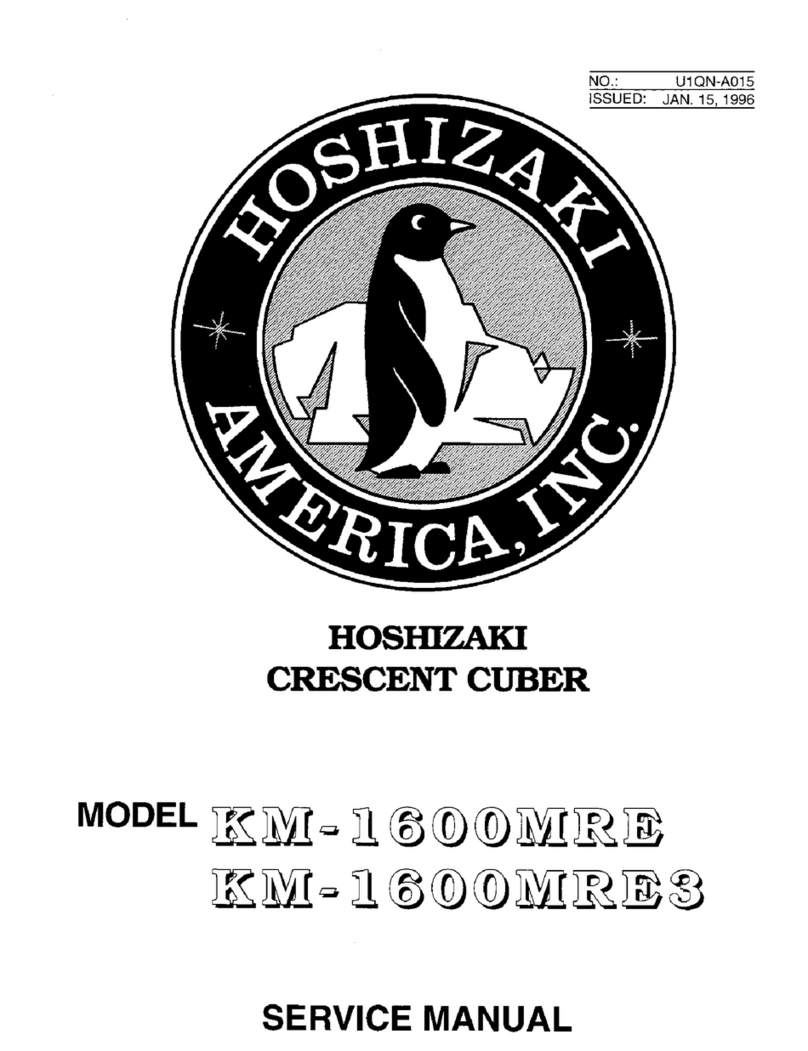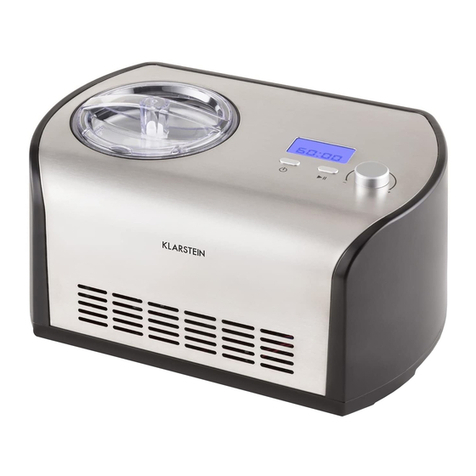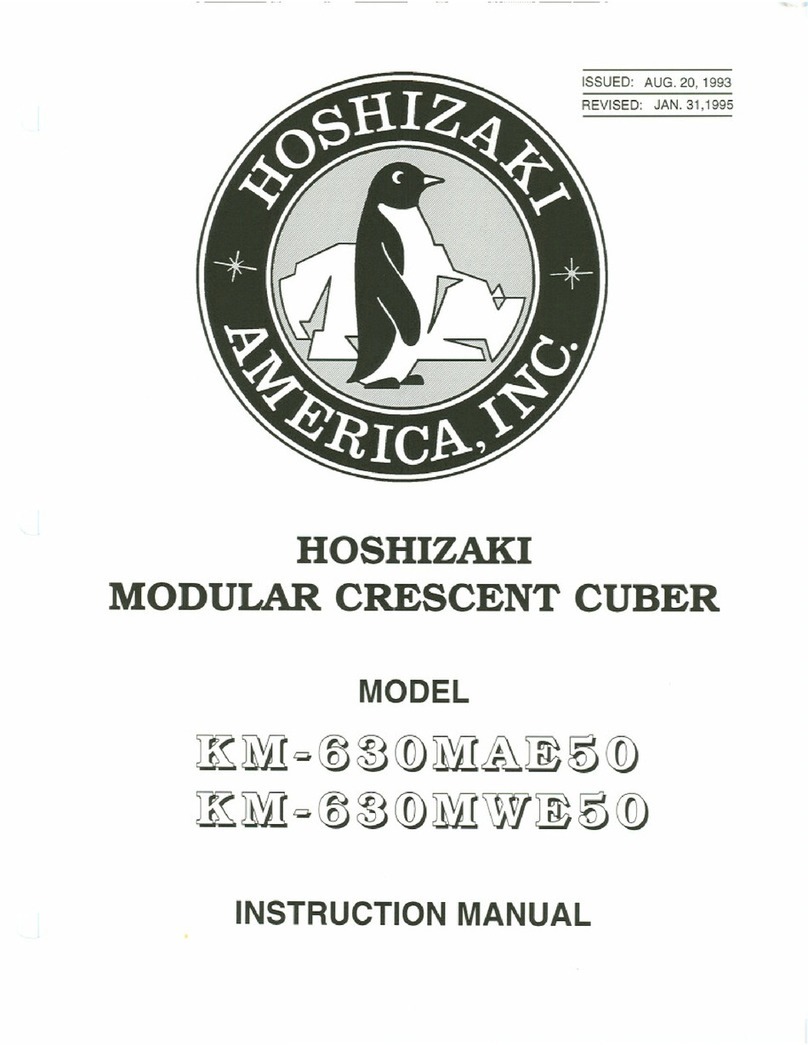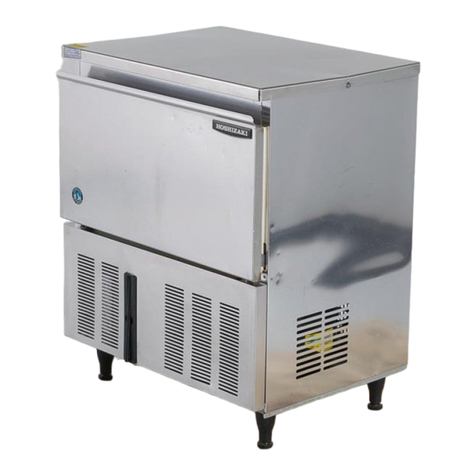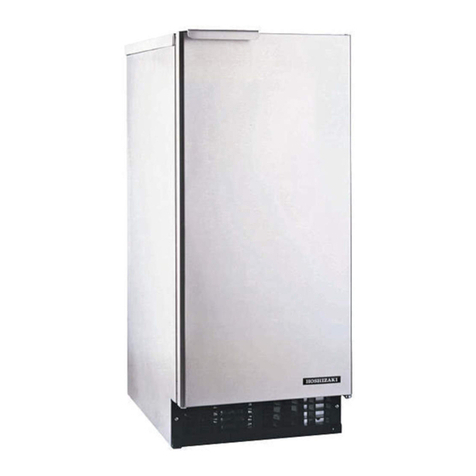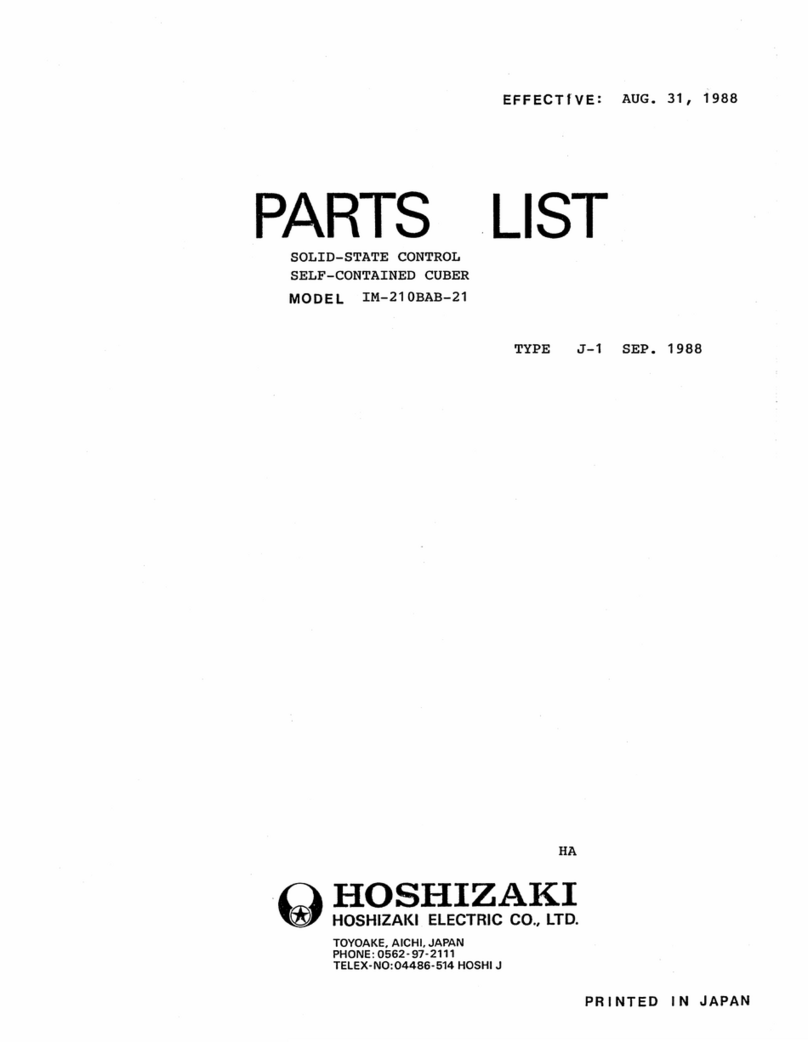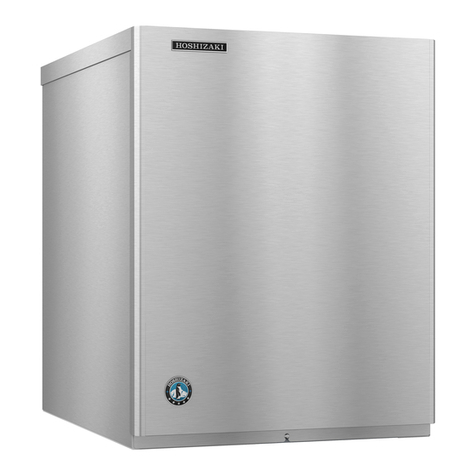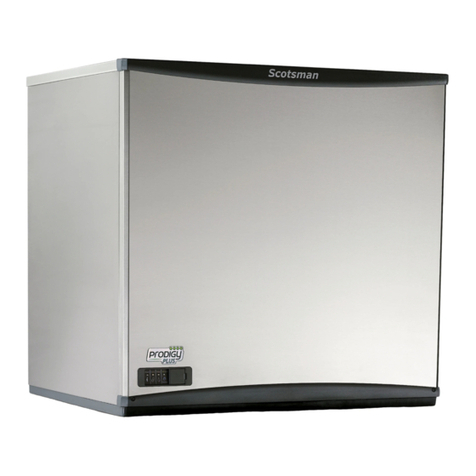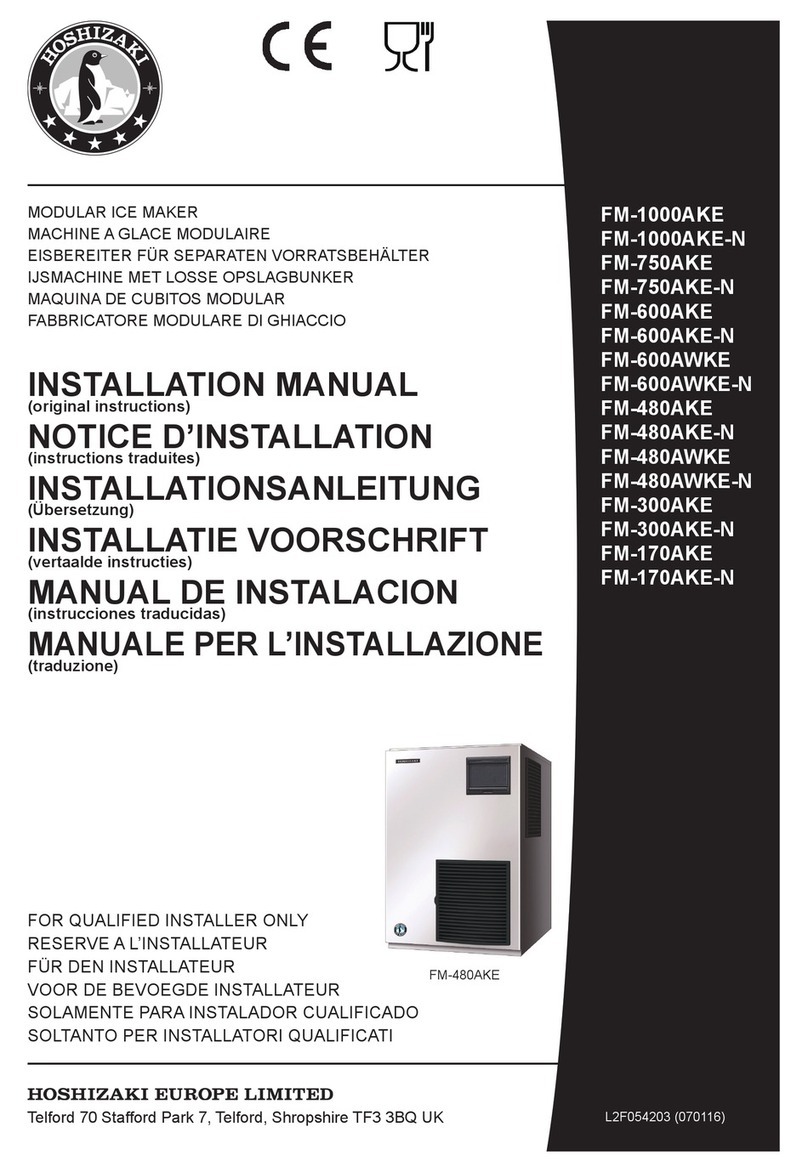SIMAG SCE 20 User manual

SERVICE MANUAL - MANUALE DI SERVIZIO
MANUEL DE SERVICE - BEDIENUNGSANLEITUNG
SCE 20
SCE 30
SCE 40
SCE 50
SCE 65
SCE 105
R 134 A
Ice cubers
Fabbricatori di ghiaccio a cubetti
Machines á glaçons
Eiswürfelbereiter
REV. 07/2019

TABLE OF CONTENTS PAGE INDICE PAG TABLE DES MATIERES PAGE INHALT SEITE
GENERAL INFORMATION INFORMAZIONI GENERALI INFORMATIONS GENERALES ALLGEMEINES UND
AND INSTALLATION 1 ED INSTALLAZIONE 11 ET INSTALLATION 22 INSTALLATION 33
Introduction 1 Introduzione 11 Introduction 22 Einleitung 33
Unpacking and inspection 1 Disimballaggio ed ispezione 11 Déballage et examen 22 Auspacken und Kontrollieren 33
Location and levelling 1
Posizionamento e livellamento
11 Logement et mise de niveau 22
Stellplatz und
Aufstellung 33
Electrical connection 2 Collegamenti elettrici 12 Branchement électrique 23 Elektrische Anschlüsse 34
Water supply and drain Alimentazione idraulica Branchement d’arrivée Wasserversorgung und
connection 2 e scarico 12 et d’évacuation eau 23 Abflußleitungen 34
Final check list 3 Controllo finale 13 Liste de contrôle final 24 Endkontrolle 35
Installation practice 3 Schema di installazione 13 Schema d’installation 24 Installation 35
OPERATING INSTRUCTION 4 ISTRUZIONI DI 14 MISE EN SERVICE 25 BETRIEBSANLEITUNG 36
FUNZIONAMENTO
Start up 4 Avviamento 14 Démarrage 25 Inbetriebnahme 36
Operational checks 4 Controlli durante il funzion. 14
Contrôle pendant le fonctionn.
25 Kontrolle bei Betrieb 36
OPERATING PRINCIPLES 6 PRINCIPIO DI 16 PRINCIPE DE 27 BETRIEB 38
FUNZIONAMENTO FONCTIONNEMENT
Freezing cycle 6 Ciclo di congelamento 16 Cycle de congélation 27 Gefrierzyklus 38
Harvest cycle 6 Ciclo di scongelamento 16 Cycle de démoulage 28 Abtauzyklus 38
CLEANING INSTRUCTIONS OF ISTRUZIONI PER LA PULIZIA
INSTRUCTION DE NETTOYAGE
ANWEISUNGEN ZUR
WATER SYSTEM 9 DEL CIRCUITO IDRAULICO 20
DU CIRCUIT HYDRAULIQUE
31
WARTUNG UND REINIGUNG
41
a)

b)
2006 mm (inch) 2508 / 3008 mm (inch) 3015 / 4015 mm (inch)
A 334 (13 1/8) 390 (15 3/8) 467 (18 3/8)
B 457 (18) 515 (20 9/32) 570 (22 7/16)
C 599 (23 9/16) 640 (25 3/16) 690 (27 3/16)
C
A
B
C
A
B
SCE 30 - 40
SCE 20

c)
5022 / 6022 mm (inch) 7540 mm (inch) 9040 mm (inch) 9550 mm (inch)
A 467 (18 3/8) 535 (21 1/16) 700 (27 1/2) 700 (27 1/2)
B 570 (22 7/16) 600 (23 5/8) 600 (23 5/8) 600 (23 5/8)
C 790 (31 1/8) 910 (35 13/16) 900 (35 7/16) 970 (38 3/16)
SCE 50 - 65
C
A
B
C
A
B
SCE 105

d)

e)
TECHNICAL SPECIFICATIONS - SPECIFICHE TECNICHE - DONNÉES TECHNIQUE - TECHNISCHE ANGABEN - R134a
SCE 20 SCE 30 SCE 40 SCE 50 SCE 65 SCE 90 SCE 105
Voltage
Tension 230/50/1 230/50/1 230/50/1 230/50/1 230/50/1 230/50/1 230/50/1
Tension -10 / +10% -10 / +10% -10 / +10% -10 / +10% -10 / +10% -10 / +10% -10 / +10%
Spannung
Condensation
Condensazione
Condensation Air Water Air Water Air Water Air Water Air Water Air Water Air Water
Kühlung
Bin capacity (kg)
Capacità contenitore (kg)
Capacité bac glaçons (kg)
6 8,5 15 22 22 39 49
Lademenge (kg)
Cubes per cycle
Cubetti per ciclo
Glaçons par cycle 15 24 24 32 32 56 56
Würfel per Zyklus
Running amps
Amperaggio di marcia
Ampérage en marche 1,9 2,1 3,3 3,3 3,2 5,8 6,3
Ampere
Starting amps
Amperaggio avviamento
Ampérage de démarrage 9,7 12 18 18 16,5 29 32
Start Ampere
Power - Watt
Potenza - Watt
Puissance - Watt 280 200 430 350 650 440 650 530 640 600 1050 800 1000 700
Leistung - Watt
Power cons. in 24 hrs - Kwh
Consumo elettr. in 24 ore - Kwh
Cons. electr. en 24 hrs - Kwh
6,5 5,4 14,5 11 10,1 12 9,6 11,8 10,5 21,1 18 19,7 17
Stromverbrauch in 24 Std. - kWh
Water consumption - lt/hr
Consumo acqua - lt/ora
Consommation eau - lt/hr 3 21 5 33 3,5 37 4 49 5 56 13,3 86 10,8 69
Wasserverbrauch - lt/hr
Wire size - mmq
Sezione cavi - mmq
Section fils - mmq 3 x 1,5 3 x 1,5 3 x 1,5 3 x 1,5 3 x 1,5 3 x 1,5 3 x 1,5
Kabelstärke - mmq
Refrigerant metering device
Disp. espansione refrigerante
Détente du Rèfrigérant Capillary tube Capillary tube Capillary tube Capillary tube Capillary tube Capillary tube Capillary tube
Kühlmittel - Expansionssystem

e / bis)
TECHNICAL SPECIFICATIONS - SPECIFICHE TECNICHE - DONNÉES TECHNIQUE - TECHNISCHE ANGABEN
SCE 20 SCE 30 SCE 40 SCE 50 SCE 65 SCE 90 SCE 105
Refrigerant
Refrigerante
Réfrigérant R134A R134A R134A R134A R134A R134A R134A
Kühlmittel
Refrig. charge - gr
Carica refrig. - gr
Charge refrig. - gr 190 160 270 240 290 250 300 270 330 290 360 330 390 400
Kühlmittel - Füll.
- gr
Hi pressure - Freezing cycle - bar
Press. mandata - ciclo congel. - bar
Haute pression cycle congel. - bar
7-11* 7-10# 10* 6-10#
7-11* 6-10# 14* 10-8# 10-7* 10-7# 8-9,5* 9,5# 8-10* 9
#
Hochdrückbereich - Gefrierfase - bar
Suction pressure - End freezing cycle - bar
Press. aspiraz. - Fine ciclo cong. - bar
Bas pression . Fin cycle congel. - bar
0-0,1 0-0,1 0-0,1 0-0,1 0-0,1 0,1-0,2 0-0,1
Niederdrückbereich - Gefrierfase - bar
*) 21°C - Room Temperature - Temperatura ambiente - Temperature ambience -
#) 15°C - Water inlet temperature - Temperatura entrata acqua - Temperature arrivé eau

WIRING DIAGRAM - SCHEMA ELETTRICO - SCHÉMA ÉLECTRIQUE - SCHALTUNGSSCHEMA
AIR & WATER COOLED - RAFFREDDAMENTO AD ARIA ED AD ACQUA.
REFROIDISSEMENT A AIR ET A EAU - LUFT- UND WASSERGEKÜHLT
230/50-60/1
f)
SCE 20 - 30 - 40 - 50

g)
WIRING DIAGRAM - SCHEMA ELETTRICO - SCHÉMA ÉLECTRIQUE - SCHALTUNGSSCHEMA
ELECTRONIC TIMER VERSION - VERSIONE CON TIMER ELETTRONICO
230/50-60/1
SCE 65 - 105

h)

SCE 40
RAFFREDDAMENTO AD ACQUA - WATER COOLED MODELS
CONDENSATION PAR EAU - WASSERKÜHLUNG
RAFFREDDAMENTO AD ARIA - AIR COOLED MODELS
CONDENSATION PAR AIR - LUFTKÜHLUNG
TEMPERATURA ACQUA - WATER TEMPERATURE
TEMPÉRATURE DE L'EAU - WASSERTEMPERATUR
TEMPERATURA AMBIENTE - AMBIENT TEMPERATURE
TEMPÉRATURE AMBIANT - RAUMTEMPERATUR
PRODUZIONE GHIACCIO PER 24 ORE - ICE PRODUCED PER 24 HRS.
PRODUCTION DE GLACE PAR 24 HEURES - EISWÜRFELPRODUKTION IN 24 STD.
42
40
38
36
34
32
30
28
26
24
22
Kg. °C
10
21
32
38
27 21 15 1032
TEMPERATURA ACQUA - WATER TEMPERATURE
TEMPÉRATURE DE L'EAU - WASSERTEMPERATUR
TEMPERATURA AMBIENTE - AMBIENT TEMPERATURE
TEMPÉRATURE AMBIANT - RAUMTEMPERATUR
PRODUZIONE GHIACCIO PER 24 ORE - ICE PRODUCED PER 24 HRS.
PRODUCTION DE GLACE PAR 24 HEURES - EISWÜRFELPRODUKTION IN 24 STD.
38
37
36
35
34
33
32
31
30
29
28
Kg. °C
10-21
32
38
27 21 15 1032
Capacità di produzione - Ice making capacity - Capacité de production - Eisproduktionskapazität
i)
21
20
19
18
17
16
15
14
13
12
11
Kg.
RAFFREDDAMENTO AD ARIA - AIR COOLED MODELS
CONDENSATION PAR AIR - LUFTKÜHLUNG
TEMPERATURA ACQUA - WATER TEMPERATURE
TEMPÉRATURE DE L'EAU - WASSERTEMPERATUR
TEMPERATURA AMBIENTE - AMBIENT TEMPERATURE
TEMPÉRATURE AMBIANT - RAUMTEMPERATUR
PRODUZIONE GHIACCIO PER 24 ORE - ICE PRODUCED PER 24 HRS.
PRODUCTION DE GLACE PAR 24 HEURES - EISWÜRFELPRODUKTION IN 24 STD.
°C
10
21
32
38
SCE 20
27 21 1532 10
21
20
19
18
17
16
15
14
13
12
11
Kg.
RAFFREDDAMENTO AD ACQUA - WATER COOLED MODELS
CONDENSATION PAR EAU - WASSERKÜHLUNG
TEMPERATURA ACQUA - WATER TEMPERATURE
TEMPÉRATURE DE L'EAU - WASSERTEMPERATUR
TEMPERATURA AMBIENTE - AMBIENT TEMPERATURE
TEMPÉRATURE AMBIANT - RAUMTEMPERATUR
PRODUZIONE GHIACCIO PER 24 ORE - ICE PRODUCED PER 24 HRS.
PRODUCTION DE GLACE PAR 24 HEURES - EISWÜRFELPRODUKTION IN 24 STD.
°C
10
21
32
38
27 21 1532 10
28
27
26
25
24
23
22
21
20
19
18
17
16
15
14
Kg.
RAFFREDDAMENTO AD ARIA - AIR COOLED MODELS
CONDENSATION PAR AIR - LUFTKÜHLUNG
TEMPERATURA ACQUA - WATER TEMPERATURE
TEMPÉRATURE DE L'EAU - WASSERTEMPERATUR
TEMPERATURA AMBIENTE - AMBIENT TEMPERATURE
TEMPÉRATURE AMBIANT - RAUMTEMPERATUR
PRODUZIONE GHIACCIO PER 24 ORE - ICE PRODUCED PER 24 HRS.
PRODUCTION DE GLACE PAR 24 HEURES - EISWÜRFELPRODUKTION IN 24 STD.
°C
10
21
32
38
SCE 30
RAFFREDDAMENTO AD ACQUA - WATER COOLED MODELS
CONDENSATION PAR EAU - WASSERKÜHLUNG
27 21 15 10
PRODUZIONE GHIACCIO PER 24 ORE - ICE PRODUCED PER 24 HRS.
PRODUCTION DE GLACE PAR 24 HEURES - EISWÜRFELPRODUKTION IN 24 STD.
TEMPERATURA ACQUA - WATER TEMPERATURE
TEMPÉRATURE DE L'EAU - WASSERTEMPERATUR
TEMPERATURA AMBIENTE - AMBIENT TEMPERATURE
TEMPÉRATURE AMBIANT - RAUMTEMPERATUR
32
28
27
26
25
24
23
22
21
20
19
18
Kg. °C
10
21
32
38
27 21 15 1032

SCE 90
RAFFREDDAMENTO AD ACQUA - WATER COOLED MODELS
CONDENSATION PAR EAU - WASSERKÜHLUNG
RAFFREDDAMENTO AD ARIA - AIR COOLED MODELS
CONDENSATION PAR AIR - LUFTKÜHLUNG
TEMPERATURA ACQUA - WATER TEMPERATURE
TEMPÉRATURE DE L'EAU - WASSERTEMPERATUR
TEMPERATURA AMBIENTE - AMBIENT TEMPERATURE
TEMPÉRATURE AMBIANT - RAUMTEMPERATUR
PRODUZIONE GHIACCIO PER 24 ORE - ICE PRODUCED PER 24 HRS.
PRODUCTION DE GLACE PAR 24 HEURES - EISWÜRFELPRODUKTION IN 24 STD.
88
87
86
85
84
83
82
81
80
79
78
77
76
75
74
73
72
71
70
69
68
67
66
65
64
63
62
61
60
Kg. °C
10
21
32
38
27 21 15 1032
TEMPERATURA ACQUA - WATER TEMPERATURE
TEMPÉRATURE DE L'EAU - WASSERTEMPERATUR
TEMPERATURA AMBIENTE - AMBIENT TEMPERATURE
TEMPÉRATURE AMBIANT - RAUMTEMPERATUR
PRODUZIONE GHIACCIO PER 24 ORE - ICE PRODUCED PER 24 HRS.
PRODUCTION DE GLACE PAR 24 HEURES - EISWÜRFELPRODUKTION IN 24 STD.
89
88
87
86
85
84
83
82
81
80
79
78
77
76
75
74
73
72
71
70
69
68
67
66
65
64
63
Kg. °C
10
21
32
38
27 21 15 1032
Capacità di produzione - Ice making capacity - Capacité de production - Eisproduktionskapazität
l)
SCE 50
RAFFREDDAMENTO AD ACQUA - WATER COOLED MODELS
CONDENSATION PAR EAU - WASSERKÜHLUNG
RAFFREDDAMENTO AD ARIA - AIR COOLED MODELS
CONDENSATION PAR AIR - LUFTKÜHLUNG
TEMPERATURA ACQUA - WATER TEMPERATURE
TEMPÉRATURE DE L'EAU - WASSERTEMPERATUR
TEMPERATURA AMBIENTE - AMBIENT TEMPERATURE
TEMPÉRATURE AMBIANT - RAUMTEMPERATUR
PRODUZIONE GHIACCIO PER 24 ORE - ICE PRODUCED PER 24 HRS.
PRODUCTION DE GLACE PAR 24 HEURES - EISWÜRFELPRODUKTION IN 24 STD.
48
47
46
45
44
43
42
41
40
39
38
37
36
35
34
33
32
31
30
29
Kg. °C
10
21
32
38
27 21 15 1032
TEMPERATURA ACQUA - WATER TEMPERATURE
TEMPÉRATURE DE L'EAU - WASSERTEMPERATUR
TEMPERATURA AMBIENTE - AMBIENT TEMPERATURE
TEMPÉRATURE AMBIANT - RAUMTEMPERATUR
PRODUZIONE GHIACCIO PER 24 ORE - ICE PRODUCED PER 24 HRS.
PRODUCTION DE GLACE PAR 24 HEURES - EISWÜRFELPRODUKTION IN 24 STD.
52
51
50
49
48
47
46
45
44
43
42
41
40
39
38
37
36
35
Kg.
27 21 15 1032
°C
10
21
32
38
SCE 65
RAFFREDDAMENTO AD ACQUA - WATER COOLED MODELS
CONDENSATION PAR EAU - WASSERKÜHLUNG
RAFFREDDAMENTO AD ARIA - AIR COOLED MODELS
CONDENSATION PAR AIR - LUFTKÜHLUNG
TEMPERATURA ACQUA - WATER TEMPERATURE
TEMPÉRATURE DE L'EAU - WASSERTEMPERATUR
TEMPERATURA AMBIENTE - AMBIENT TEMPERATURE
TEMPÉRATURE AMBIANT - RAUMTEMPERATUR
PRODUZIONE GHIACCIO PER 24 ORE - ICE PRODUCED PER 24 HRS.
PRODUCTION DE GLACE PAR 24 HEURES - EISWÜRFELPRODUKTION IN 24 STD.
58
57
56
55
54
53
52
51
50
49
48
47
46
45
44
43
42
41
40
39
38
37
36
Kg. °C
10-21
32
38
27 21 15 1032
TEMPERATURA ACQUA - WATER TEMPERATURE
TEMPÉRATURE DE L'EAU - WASSERTEMPERATUR
TEMPERATURA AMBIENTE - AMBIENT TEMPERATURE
TEMPÉRATURE AMBIANT - RAUMTEMPERATUR
PRODUZIONE GHIACCIO PER 24 ORE - ICE PRODUCED PER 24 HRS.
PRODUCTION DE GLACE PAR 24 HEURES - EISWÜRFELPRODUKTION IN 24 STD.
63
62
61
60
59
58
57
56
55
54
53
52
51
50
49
48
47
46
45
44
43
42
41
Kg.
27 21 15 1032
°C
10
21
32
38

Capacità di produzione - Ice making capacity - Capacité de production - Eisproduktionskapazität
m)
SCE 105
RAFFREDDAMENTO AD ACQUA - WATER COOLED MODELS
CONDENSATION PAR EAU - WASSERKÜHLUNG
RAFFREDDAMENTO AD ARIA - AIR COOLED MODELS
CONDENSATION PAR AIR - LUFTKÜHLUNG
TEMPERATURA ACQUA - WATER TEMPERATURE
TEMPÉRATURE DE L'EAU - WASSERTEMPERATUR
TEMPERATURA AMBIENTE - AMBIENT TEMPERATURE
TEMPÉRATURE AMBIANT - RAUMTEMPERATUR
PRODUZIONE GHIACCIO PER 24 ORE - ICE PRODUCED PER 24 HRS.
PRODUCTION DE GLACE PAR 24 HEURES - EISWÜRFELPRODUKTION IN 24 STD.
89
88
87
86
85
84
83
82
81
80
79
78
77
76
75
74
73
72
71
70
69
68
67
66
65
64
63
Kg. °C
10-21
32
38
27 21 15 1032
TEMPERATURA ACQUA - WATER TEMPERATURE
TEMPÉRATURE DE L'EAU - WASSERTEMPERATUR
TEMPERATURA AMBIENTE - AMBIENT TEMPERATURE
TEMPÉRATURE AMBIANT - RAUMTEMPERATUR
PRODUZIONE GHIACCIO PER 24 ORE - ICE PRODUCED PER 24 HRS.
PRODUCTION DE GLACE PAR 24 HEURES - EISWÜRFELPRODUKTION IN 24 STD.
96
95
94
93
92
91
90
89
88
87
86
85
84
83
82
81
80
79
78
77
76
75
74
73
72
Kg. °C
10
21
32
38
27 21 15 1032

7. See data plate on the rear side of the unit
and check that local main voltage corresponds
with the voltage specified on it.
CAUTION. Incorrect voltage supplied to
the icemaker will void your parts
replacement program.
8. Remove the manufacturer’s registration
card from the inside of the User Manual and fill-
in all parts including: Model and Serial Number
taken from the data plate.
Forward the completed self-addressed
registration card to the factory.
C. LOCATION AND LEVELLING
WARNING. This Ice Cuber is designed for
indoor installation only. Extended periods
of operation at temperatures exceeding
the following limitations will constitute
misuse under the terms of the
Manufacturer’s Limited Warranty
resulting in LOSS of warranty coverage.
1. Position the unit in the selected permanent
location.
Criteria for selection of location include:
a) Minimum room temperature 10°C (50°F)
and maximum room temperature 40°C (100°F).
b) Water inlet temperatures: minimum 5°C
(40°F) and maximum 35°C (90°F).
c) Well ventilated location for air cooled
models. Clean the air cooled condenser at
frequent intervals.
d) Service access: adequate space must
be left for all service connections through the rear
of the ice maker. A minimum clearance of 15 cm
(6") must be left at the sides of the unit for routing
cooling air drawn into and exhausted out of the
compartment to maintain proper condensing
operation of air cooled models.
NOTE.
With the unit in “built-in” conditions,
the ice production is gradually reduced in
respect to the levels shown in the graph, up
to a maximum of 10% at room temperatures
higher than 32
°
C.
The daily ice-making capacity is directly
related to the condenser air inlet temperatu-
re, water temperature and age of the machine.
To keep your CUBER at peak performance
levels, periodic maintenance checks must
be carried out as indicated on Cleaning
Section of this manual.
2. Level the unit in both the left to right and
front to rear directions.
Page 1
GENERAL INFORMA TION
AND INSTALLATION
A. INTRODUCTION
These Cubers are quality designed, engineered
and manufactured.
Their ice making systems are thoroughly tested
providing the utmost in flexibility to fit the needs
of a particular user.
These ice makers have been engineered to our
own rigid safety and performence standards.
NOTE.
To retain the safety and performance
built into this icemaker, it is important that
installation and maintenance be conducted
in the manner outlined in this manual.
B. UNPACKING AND INSPECTION
1. Visually inspect the exterior of the packing
and skid. Any severe damage noted should be
reported to the delivering carrier and a concealed
damage claim form filled in subjet to inspection of
the contents with the carrier’s representative
present.
2. a) Cut and remove the plastic strip securing
the carton box to the skid.
b) Cut open the top of the carton and
remove the polystyre protection sheet.
c) Pull out the polystyre posts from the
corners and then remove the carton.
3. Remove the front and the rear panels of the
unit and inspect for any concealed damage.
Notify carrier of your claim for the concealed
damage as stated in step 1 above.
4. Open the bin door and remove all internal
support packing and masking tape.
5. Check that refrigerant lines do not rub
against or touch other lines or surfaces, and that
the fan blade moves freely.
6. Use clean damp cloth to wipe the surfaces
inside the storage bin and the outside of the
cabinet.

Page 2
D. ELECTRICAL CONNECTIONS
See data plate for current requirements to
determine wire size to be used on electrical
connections. All icemakers require a solid earth
wire.
The ice machines are supplied from the factory
completely pre-wired and require only electrical
power connections to wire cord provided on the
back of the unit.
Make sure that the ice machine is connected to
its own circuit and individually fused (see data
plate for fuse size).
The maximum allowable voltage variation should
not exceed -10% and +10% of the data plate
rating. Low voltage can cause faulty functioning
and may be responsible for serious damage to
the overload switch and motor windings.
NOTE.
All external wiring should conform to
national, state and local standards and
regulations.
Check voltage on the line and the ice maker’s
data plate before connecting the unit.
E. WATER SUPPLY AND DRAIN
CONNECTIONS
General
When choosing the water supply for the ice cuber
consideration should be given to:
a) Length of run
b) Water clarity and purity
c) Adequate water supply pressure
Since water is the most important single ingredient
in producting ice you cannot emphasize too
much the three items listed above.
Low water pressure, below 1 bar may cause
malfunction of the ice maker unit.
Water containing excessive minerals will tend to
produce cloudy coloured ice cubes, plus scale
built-up on parts of the water system.
Water supply
Connect the 3/4" male fitting of the solenoid
water inlet valve, using the flexible hose supplied,
to the cold water supply line with regular plumbing
fitting and a shut-off valve installed in an
accessible position between the water supply
line and the unit.
Water supply - Water cooled models
(SCE 90 - 105)
The water cooled versions of SCE 90 - 105 models
require two separate inlet water supplies, one for
the water sprayed for making the ice cubes and
the other for the water cooled condenser.
Connect the 3/4" male fitting of the water
regulating valve using the flexible hose supplied
with the unit to the cold water supply line with
regular plumbing fitting and a shut-off valve
installed in an accessible position between the
water supply line and the unit.
Water drain
The recommended drain tube is a plastic or
flexible tube with 18 mm (3/4") I.D. runs to an
open trapped and vented drain. When the drain
is a long run, allow 3 cm pitch per meter (1/4"
pitch per foot).
A vertical open vent, at the unit drain connection,
is also required for proper sump drainage.
Water drain - Water cooled models
The water drain line from the condenser, on
water cooled versions, is internally connected
with the drain fitting of the unit.
It is strongly recommended therefore to install a
vertical open vent on unit drain line high point to
ensure good draining and to direct the drain line
to a trapped and vented floor drain receptacle.
This to make sure of the proper flow of the
drained water as, in case of poor drainage, the
water ranning out from the condenser may
inopportunely flow, through the unit drain tubing,
into the ice storage bin.
NOTE.
The water supply and the water drain
must be installed to conform with the local
code. In some case a licensed plumber and/
or a plumbing permit is required.

F. FINAL CHECK LIST
1. Is the unit in a room where ambient
temperatures are within a minimum of 10 °C
(50°F) even in winter months?
2. Is there at least a 15 cm (6") clearance
around the unit for proper air circulation?
3. Is the unit level? (IMPORTANT)
4. Have all the electrical and plumbing
connections been made, and is the water supply
shut-off valve open?
5. Has the voltage been tested and checked
against the data plate rating?
6. Has the water supply pressure been
checked to ensure a water pressure of at least
G. INSTALLATION PRACTICE
1. Hand shut-off valve
2. Water filter
3. Water supply line (flexible hose)
4. 3/4" male fitting
5. Vented drain
6. Open trapped vented drain
7. Drain fitting
8. Main switch
9. Power line
1 bar (14 psi).
7. Check all refrigerant lines and conduit lines
to guard against vibrations and possible failure.
8. Have the bin liner and cabinet been wiped
clean?
9. Has the owner/user been given the User
Manual and been instructed on the importance of
periodic maintenance checks?
10. Has the Manufacturer’s registration card
been filled in properly? Check for correct model
and serial number against the serial plate and
mail the registration card to the factory.
11. Has the owner been given the name and
the phone number of the authorized Service
Agency serving him?
WARNING. This icemaker is not designed for outdoor installation and will not function in
ambient temperatures below 10°C (50°F) or above 40°C (100°F).
This icemaker will malfunction with water temperatures below 5 °C (40°F) or above 35 °C
(90°F).
Page 3

OPERATING INSTRUCTIONS
START UP
After having correctly installed the ice maker and
completed the plumbing and electrical
connections, perform the following “Start-up”
procedure.
SCE 20-30-40-50
A. Remove the unit front panel and locate the
cleaning switch on the control box.
B. Set the cleaning switch in the cleaning
position (II). This will close the electrical circuit to
the water inlet valve and to the hot gas valve.
C. Switch ON the power line disconnect switch.
Unit will start up in water filling phase mode.
During this phase the components energized
are:
WATER INLET SOLENOID VALVE
HOT GAS SOLENOID VALVE
The Water pump and the Fan motor are also in
operation.
D. Let unit stay in water filling phase mode for
about three/four minutes till water is coming out
from the drain hose, then move the cleaning
switch to the operation position (I).
SCE 65-90-105
A. Give power to the unit to start it up by
switching ON the power line main switch; the unit
will start automatically in defrost cycle with the
following components energized:
WATER INLET SOLENOID VALVE
HOT GAS VALVE
COMPRESSOR
ELECTRONIC TIMER
NOTE.
During the defrost cycle, the water
inlet solenoid valve is energized. The water
flows through the valve to the back side of the
evaporator platen and then down to fill up the
icemaker sump tank for the next freezing cycle.
OPERATIONAL CHECKS
A. The unit now starts its first freezing cycle
with the following components in operation:
COMPRESSOR
WATER PUMP
FAN MOTOR in air cooled version
B. Check to see through the ice discharge
opening that the spray system is correctly seated
and that the water jets uniformely reach the
interior of the inverted cup molds; also make sure
that the plastic curtain is hanging freely and there
is not excessive water spilling through it.
C. The ice making process takes place thereby,
with the water sprayed into the molds that gets
gradually refrigerated by the heat exchanged
with the refrigerant flowing into the evaporator
serpentine.
D. On units SCE 20 -30 - 40 . 50 when the
evaporator temperature reaches a preset value
the evaporator thermostat or cube size control
changes its contacts; the freezing cycle ends and
starts the defrost or harvest cycle.
E. On models SCE 65 - 90 - 105 freezing cycle
is completed through an electronic timer
energized by the evaporator thermostat. It starts
when the cube size thermostat/control bulb (pig
tail) located on the evaporator serpentine reaches
a temperature of approx. -15°C (5°F)
.
On units SCE 65 - 90 - 105 the additional
Time (12') of the freezing cycle starts when
the cube size thermostat control bulb (pig
tail) located on the evaporator coil reaches a
temperature of approx. -15
°
C. Freezing time
will range between 20 and 22 minutes in a
21
°
C ambient temperature, longer if above
this temperature and shorter if below.Then
the unit goes directly into the Defrost Cycle.
The average complete cycle time is between
23 and 25 minutes.
F. Check, during the first defrost/harvest cycle,
that the incoming water flows correctly into the
sump reservoir in order to re-fill it and the
surplus
overflows through the overflow drain tube.
G. Check the texture of ice cubes just released.
Right size must have a small depression (about
5-6 mm) in their crown.
If not, wait for the second defrost/harvest cycle
before performing any adjustment.
H.
If required on model SCE 20 - 30 - 40 - 50
, the
length of the freezing cycle can be modified by
turning the knob of the cube size control or
evaporator thermostat located
in front of the machine
until the desired size is achieved.
Page 4

If it is thought necessary, the above situations
can be rectified by, in the first case, turning the
control knob (as little or as much as is required)
clockwise and, in the second case, turning the
knob to the right counterclockwise.
It should, however, be remembered that if the
room temperature returns later to the 20 ÷ 30°C
range, the knob indicator must once again be
turned to the previous position.
If the ice cubes are shallow and cloudy, it is
possible that the ice maker runs short of water
during the end of the freezing cycle or, the quality
of the supplied water requires the use of an
appropriate water filter or conditioner.
I. At the end of the defrost or harvest cycle
hold a handful of ice cubes against the bulb of the
storage bin thermostat; the icemaker switch OFF
in about one-two minutes.
Take out the ice from the storage bin thermostat.
The ice maker should restart automatically in
three-four minutes.
NOTE.
The bin thermostat is factory set at
1
°
C (35
°
F) OUT and 4
°
C (39
°
F) IN.
K. Re-fit the unit front panel then instruct the
owner/user on the general operation of the ice
machine and about the cleaning and care it
requires.
Page 5
• If the tempera-
ture of the room in
which the machine
is place is below
20°C, the cubes
will tend to be
partly hollowed
out (see fig. on
right).
• If, on the other
hand, the room
temperature is
above 30 °C the
cubes produced
will have a jagged
rim of ice around
the crown.

PRINCIPLE OF OPERATION
How it works
In the ice makers the water used to make the ice
is kept constantly in circulation by a water pump
which primes it to the spray system nozzles from
where it is diverted into the inverted cup molds of
the evaporator (Fig. A).
A small quantity of the sprayed water freezes into
ice; the rest of it cascades by gravity into the
sump assembly below for recirculation.
FREEZING CYCLE (Fig. B)
The hot gas refrigerant discharged out from the
compressor reaches the condenser where, being
cooled down, condenses into liquid. Flowing into
the liquid line it passes through the drier/filter,
then it goes all the way through the capillary tube
where it looses its pressure.
Next the refrigerant enters into the evaporator
serpentine (which has a larger diameter then the
capillary tube) and starts to boil off; this reaction
is emphasized by the heat transferred by the
sprayed water.
The refrigerant then increases in volume and
changes entirely into vapor.
The vapor refrigerant then passes through the
suction accumulator (used to prevent that any
small amount of liquid refrigerant may reach the
compressor) and through the suction line. In both
the accumulator and the suction line it exchanges
heat with the refrigerant flowing into the capillary
tube (warmer), before to be sucked in the
compressor and to be recirculated as hot
compressed refrigerant gas.
The freezing cycle on SCE 20 - 30 - 40 - 50 is
controlled by only the evaporator thermostat
which has its bulb in contact with the evaporator
serpentine while in SCE 65 - 90 - 105 there is
an second phase controlled by an electronic
timer.
The electrical components in operation during
the freezing cycle are:
COMPRESSOR
WATER PUMP
FAN MOTOR (in air cooled version)
On air cooled versions the refrigerant head
pressure is gradually reduced from the value of
approx. 11 bar at beginning of the freezing cycle
with the machine at 21°C ambient temperature,
to a minimum value of approx. 7 bar just at the
end of the freezing cycle, few seconds before the
starting of the defrost cycle.
The declining of the pressure is relied to the
reduction of the evaporating pressure, caused
by the progressive growth of the ice thickness
into the inverted cup molds and to the flow of air
drown through the air cooled condenser by the
fan motor.
The above values are in relation as well to the
ambient temperature of the ice maker site and
they are subject to rise with the increase of this
temperature.
On water cooled versions the refrigerant head
pressure ranges between 8,5 and 10 bar being
controlled by an automatic hi pressure control
that energizes a water solenoid valve located on
the water line to the condenser, which rates the
cooling water to the condenser.
On SCE 90 - 105 water cooled version operating,
the head pressure is constant controlled by a
water regulating valve.
At starting of the freezing cycle the refrigerant
suction or lo-pressure lowers rapidly to 1,0 bar
then it declines gradually – in relation with the
growing of the ice thickness – to reach, at the end
of the cycle, approx. 0-0,1 bar with the cubes fully
formed in the cup molds.
DEFROST OR HARVEST CYCLE (Fig. D)
On SCE 20 - 30 - 40 - 50 the temperature of the
evaporator thermostat, in contact with the
evaporator serpentine, drops to a pre-set value
it changes its electrical contacts energizing
the herebelow shown components.
(On SCE 65 - 90 - 105 when the electro-nic timer
completes the second portion of the freezing it
changes its electrical contacts energizing the
same components).
COMPRESSOR
WATER INLET SOLENOID VALVE
HOT GAS SOLENOID VALVE
The incoming water, passing through the water
inlet valve and the flow control, runs over the
evaporator platen and then flows by gravity
through the dribbler holes down into the sump/
reservoir (Fig. C).
The water filling the sump/reservoir forces part of
the surplus water from the previous freezing
cycle to go out to the waste through the overflow
pipe. This overflow limits the level of the sump
water which will be used to produce the next
batch of ice cubes.
Meanwhile the refrigerant, as hot gas discharged
from the compressor, flows through the hot gas
valve directly into the evaporator serpentine by-
passing the condenser.
Page 6

The hot gas circulating into the serpentine of the
evaporator warms up the copper molds causing
the harvest of the ice cubes. The ice cubes,
released from the cups, drop by gravity onto a
slanted cube chute, then through a curtained
opening they fall into the storage bin.
On SCE 20 - 30 - 40 - 50 when the temperature
of the evaporator thermostat bulb reaches the
value of +3 ÷4°C their electrical contacts move
back to the previous position activating a new
freezing cycle and deenergizing both the hot gas
and the water inlet valves (closed).
On SCE 65 - 90 - 105 as soon as the electronic
timer completes the defrost cycle, it activates a
new freezing cycle deenergizing both the hot gas
and the water inlet valves (closed).
NOTE. On models SCE 20 - 30 - 40 - 50 the
length of the defrost/harvest cycle (not
adjustable) changes according to the
ambient temperature (shorter for hi ambient
temperature and longer for low one).
COMPONENTS DESCRIPTION
A. WATER PUMP
The water pump operates continually throughout
the freezing cycle. The pump primes the water
from the sump to the spray system and through
the spray nozzles sprays it into the inverted cup
molds to be frozen into crystal clear ice cubes.
B. WATER INLET SOLENOID VALVE -
3/4 MALE FITTING
The water inlet solenoid valve is energized only
during the defrost cycle.
When energized it allows a metered amount of
incoming water to flow over the evaporator cavity
to assist the hot gas in defrosting the ice cubes.
The water running over the evaporator cavity
drops by gravity, through the dribbler holes of the
platen, into the sump reservoir.
On SCE 20 - 30 - 40 - 50 water cooled versions
the water inlet solenoid valve has one inlet and
two outlets with two separate solenoids energized
the first (ice productioon) by the contacts 3-2 of
the evaporator thermostat and the second (water
cooled condenser) by a specific hi pressure
control.
C. HOT GAS SOLENOID VALVE
The hot gas solenoid valve consists basically in
two parts: the valve body and the valve coil.
During the defrost cycle the hot gas valve coil is
activated so to attract the hot gas valve piston in
order to give way to the hot gas discharged from
compressor to flow directly into the evaporator
serpentine to defrost the formed ice cubes.
D. BIN THERMOSTAT
The bin thermostat control body is located in the
front of control box behind the front panel.
The thermostat sensing tube is located into a
bulb holder on the side wall of the ice storage bin
where it automatically shuts the icemaker OFF
when in contact with the ice and re-starts the
icemaker when the ice is removed. Factory
settings are 1°C (35°F) OUT and 4°C (39°F) IN.
E. CUBE SIZE CONTROL (EVAPORATOR
THERMOSTAT)
SCE 20 - 30 - 40 - 50
The cube size control (evaporator thermostat)
body is located in the control box behind the front
panel; it’s basically a reverse acting temperature
control which closes the contacts 3-2 when its
temperature decreases and closes the opposite
contacts 3-4 when the temperature rises.
The thermostat sensing bulb is located into a
plastic tube (bulb holder) secured by two clips
directly to the evaporator serpentine.
This control determines the length of the freezing
cycle and correspondingly the size of the cubes.
A lower setting will produce a larger cube
(oversize) while a higher setting a smaller cuber
(shallow size).
When closed on contacts 3-2 it activates the
defrost or harvest cycle components.
The cube size control is set up in the factory
(knob in the black dot position) and doesn't
require any adjustment when the ambient
temperature remains between 20 and 30 °C
(70 and 90°F).
SCE 65 - 90 - 105
The evaporator thermostat with its sensing bulb
intimately in contact with the regrigerant outlet
tube from the evaporator senses the evaporating
refrigerant temperature (which declines in the
course of the freezing cycle) and when this one
reaches the pre-set value, it switches its contacts
from 3-4 to 3-2 to activate the finishing cycle (2nd
phase) through an electronic timer.
F. FAN MOTOR (Air cooled version)
The fan motor on SCE 20 - 30 - 40 - 50 is
electrically connected in parallel to the water
pump and it operates continuously only during
the freezing cycle keeping the proper head
pressure by circulating air through the condenser
fins.
On SCE 65 - 90 - 105 the operation of fan motor
is controlled by a fan pressure control adjusted at
preset values.
G. COMPRESSOR
The hermetic compressor is the heart of the
refrigerant system and it is used to circulate and
retrieve the refrigerant throughout the entire
system. It compresses the low pressure
refrigerant vapor causing its temperature to rise
and become high pressure hot vapor (hot gas)
which is then released through the discharge
valve.
H. WATER SPRAY SYSTEM
Through its nozzles it sprays the water in each
individual cup to be frozen into ice.
Page 7
This manual suits for next models
5
Table of contents
Languages:
Other SIMAG Ice Maker manuals
Popular Ice Maker manuals by other brands

Hoshizaki
Hoshizaki KM-1100MAJ50 instruction manual

Scotsman
Scotsman C2648MR-3 Installation and user manual

KitchenAid
KitchenAid KUIS185DAL0 parts list
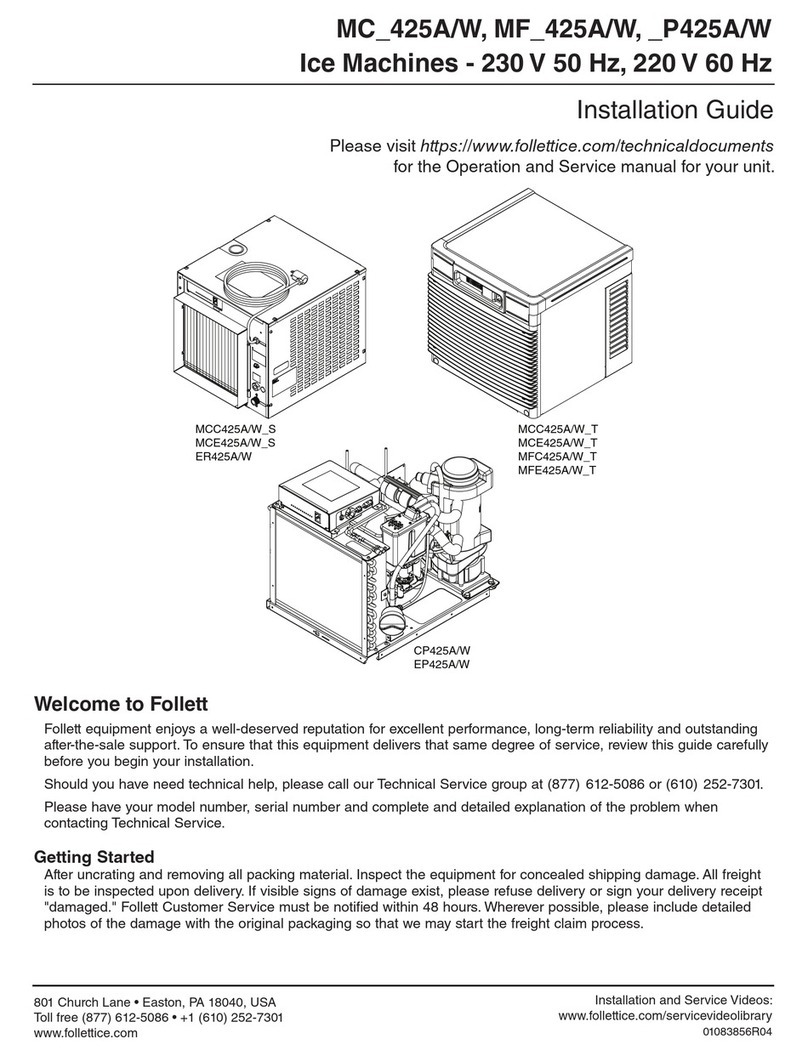
Follett
Follett Maestro Plus MC 425A Series installation guide
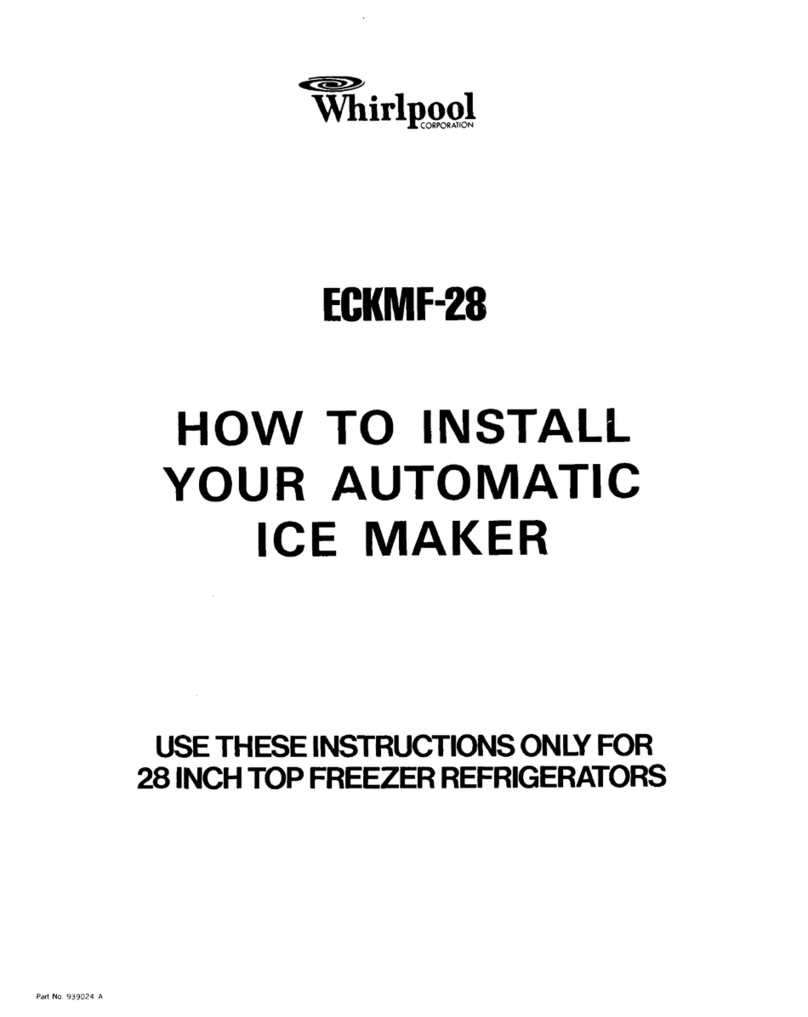
Whirlpool
Whirlpool ECKMF-28 installation instructions
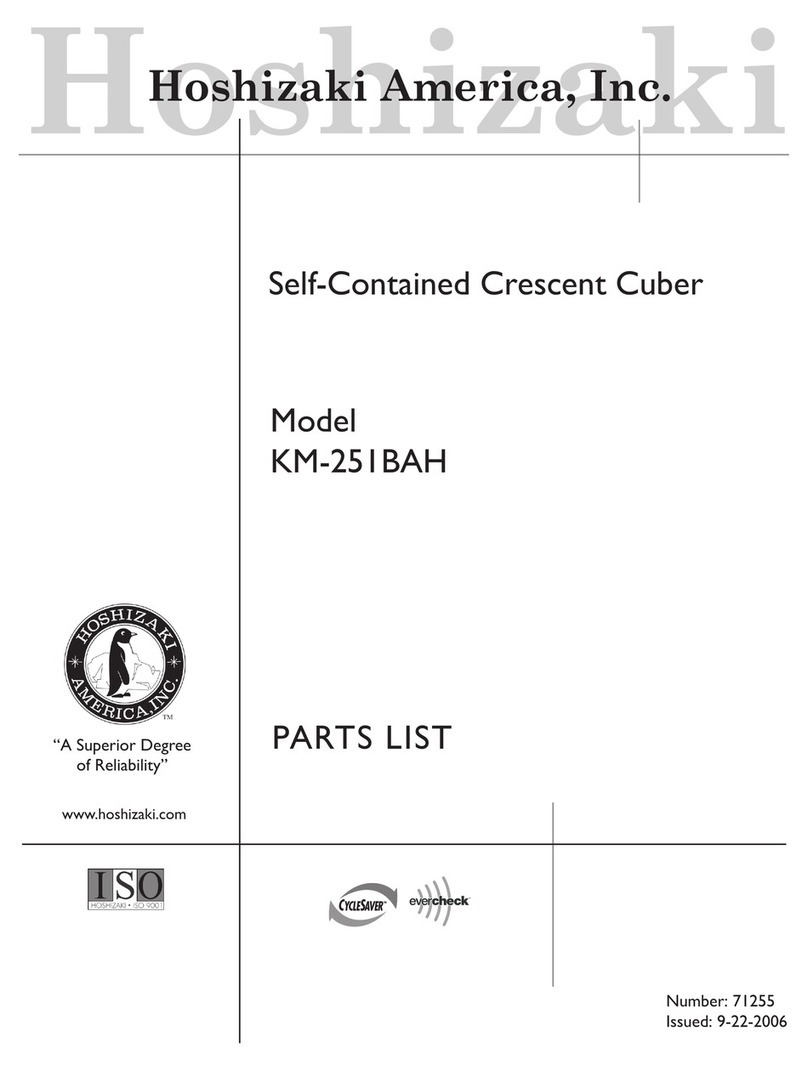
Hoshizaki
Hoshizaki KM-251BAH parts list
